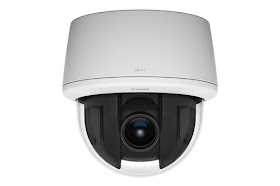MELVILLE, N.Y., March 30, 2016 – Canon U.S.A., Inc., a leader in digital imaging solutions, today unveiled five new network cameras with advanced capabilities designed to effectively meet the needs of indoor and outdoor applications in a wide range of markets. All five cameras share several core technologies and features including a Genuine Canon Lens for capturing high-clarity, virtually distortion-free video, a 2.1 Megapixel (1920 x 1080) resolution high sensitivity CMOS sensor, and Canon’s powerful DIGIC DV III Image Processor which helps to provide images with remarkable color accuracy even in low-light environments.
“The importance of security and surveillance continues to increase for all types of markets and sectors,” stated Yuichi Ishizuka, president and COO, Canon U.S.A., Inc. “With the announcement of these new high-performance indoor and outdoor models, Canon is once again demonstrating its strong commitment to developing network cameras that meet the ever-changing needs of these varied industries.”
Outdoor/Indoor Speed Dome Network Cameras
Canon’s new Speed Dome Network Cameras, the VB-R12VE (outdoor) and VB-R13 (indoor), both offer seamless PTZ control provided by 360 degrees endless panning capability. In addition to 30x optical zoom for crisp images even from long distances, these cameras also share an Enhanced Digital Zoom function that can offer up to an equivalent 120x optical zoom when streaming at lower resolutions. Adding to their user-friendliness and ease of PTZ control is the ability to create up to 256 preset positions and up to five tour routes. Canon optical encoders, micro-stepping motors, and a timing belt enable these models to provide fast (up to 450 degrees per second), precise panning and tilting.
With a robust weather- and vandal-resistant housing and built-in heater, the VB-R12VE camera is outdoor ready and able to withstand a variety of challenging environments. This model is also available with audio and external I/O support as the VB-R13VE.
VB-H651V Vandal Resistant Indoor Fixed Dome Network Camera
The VB-H651V is Canon’s newest Indoor Fixed Dome Network Camera to feature the company’s unique Remote PTRZ Adjustment function for easy post-installation changes to the camera’s pan, tilt, zoom and rotation positions. A vandal-resistant enclosure helps facilitate this camera’s safety from impact and tampering. The VB-H651V camera’s ability to deliver high-quality video is supported by an Auto Focus function for clear focusing on subjects both near and far away. This camera comes with a mounting plate to enable fast and simple installation, and it has multiple power options for installation flexibility, including 24 V AC, 12 V DC and PoE.
VB-H652LVE Infrared Vandal Resistant Outdoor Fixed Dome Network Camera
Canon also introduced the VB-H652LVE, its new infrared outdoor-ready Fixed Dome Network Camera which has a vandal-resistant, water-tight housing and optional heater unit making it suitable for installation in many climates. It is equipped with four built-in IR illuminators that enable video to be captured in little to no visible light, and an Auto Focus function for clear focusing on subjects both near and far away. It offers analog video output and installation controls for simple camera positioning during installation, and multiple power options including 24 V AC, 12 V DC, PoE and PoE+ provide further installation flexibility.
Convenience and Versatility
For added versatility, all of these new Canon network cameras have the ability to stream in both 16:9 and 4:3 resolutions, and also offer Custom Video Settings for optimal image exposure according to time of day and conditions (includes shutter speed, iris, gain, white balance, and noise reduction). Two available features, Motion Adaptive Noise Reduction and Area-Specific Data Size Reduction (ADSR), are both designed to help reduce data size while also helping to improve the image quality of areas of interest. These cameras are suitable for installation in areas with frequent vibrations – such as on top of a pole or near heavy machinery – as an Image Stabilization feature enables them to deliver clear video with minimal motion blurring.
The simple setup and use offered by these new Network Cameras is furthered by a Camera Viewer and a Mobile Viewer that provide easy access to the camera’s features and functionality from a variety of different compatible devices including PCs, mobile phones and tablets. All of these cameras are ONVIF Profile S and Profile G Conformant to help facilitate maximum interoperability with third-party recorders, and all also include a Canon Camera Management Tool (CCMT) that allows for centralized management of all current Canon Network Cameras (camera discovery, configuration, back-ups and restores, firmware upgrades, etc.).


































